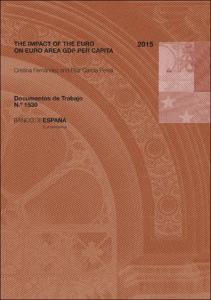The impact of the euro on euro area GDP per capita
Authors
Issue Date
13-Nov-2015
Physical description
31 p. : gráf., tab.
Abstract
Este artículo aborda la siguiente pregunta: ¿cuál habría sido el PIB per cápita del área del euro si no se hubiese creado la unión monetaria? Para intentar contestarla, utilizamos la metodología de control sintético [Abadie y Gardeázabal (2003) y Abadie et al. (2010)]. Nuestros resultados señalan que el euro no trajo consigo el salto esperado hacia una senda de crecimiento mayor del PIB per cápita. Durante los primeros años de la unión monetaria, el PIB per cápita del área avanzó ligeramente por encima de la senda predicha por su contrafactual
pero desde mediados del 2000 estas ganancias desaparecieron completamente. Los países de Europa central —Alemania, Países Bajos y Austria— siguieron una pauta muy similar a la del agregado. Sin embargo, entre los países de la periferia obtenemos resultados heterogéneos. Irlanda, España y Grecia registraron ganancias positivas y significativas, aunque solo durante los años de expansión inmediatamente posteriores al lanzamiento del euro. Por su parte, Italia y Portugal registraron desde el primer momento una senda de PIB per cápita inferior a la prevista por sus contrafactuales. En el estudio se comprueba la robustez de la estimación sintética no solo a la exclusión de países de la bolsa de donantes, sino también tanto a la exclusión como a la reducción del número de variables explicativas del PIB per cápita
This paper poses the following question: what would euro area GDP per capita have been, had the monetary union not been launched? To this end we use the synthetic control methodology. We find that the euro did not bring the expected jump to a permanent higher growth path. During the early years of the monetary union, aggregate GDP per capita in the euro area rose slightly above the path predicted by its counterfactual
but since the mid- 2000s, these gains have been completely eroded. Central European countries – Germany, the Netherlands and Austria – did not seem to obtain any gains or losses from the adoption of the euro. Ireland, Spain and Greece registered positive and significant gains, but only during the expansionary years that followed the launch of the euro, while Italy and Portugal quickly lagged behind the GDP per capita predicted by their counterfactual. We test the robustness of the synthetic estimation not only to the exclusion of any particular country from the donor pool but also to the omission of each of the selected determinants of GDP per capita and to the reduction of the dimensions in the optimisation programme, namely the number of GDP determinants
pero desde mediados del 2000 estas ganancias desaparecieron completamente. Los países de Europa central —Alemania, Países Bajos y Austria— siguieron una pauta muy similar a la del agregado. Sin embargo, entre los países de la periferia obtenemos resultados heterogéneos. Irlanda, España y Grecia registraron ganancias positivas y significativas, aunque solo durante los años de expansión inmediatamente posteriores al lanzamiento del euro. Por su parte, Italia y Portugal registraron desde el primer momento una senda de PIB per cápita inferior a la prevista por sus contrafactuales. En el estudio se comprueba la robustez de la estimación sintética no solo a la exclusión de países de la bolsa de donantes, sino también tanto a la exclusión como a la reducción del número de variables explicativas del PIB per cápita
This paper poses the following question: what would euro area GDP per capita have been, had the monetary union not been launched? To this end we use the synthetic control methodology. We find that the euro did not bring the expected jump to a permanent higher growth path. During the early years of the monetary union, aggregate GDP per capita in the euro area rose slightly above the path predicted by its counterfactual
but since the mid- 2000s, these gains have been completely eroded. Central European countries – Germany, the Netherlands and Austria – did not seem to obtain any gains or losses from the adoption of the euro. Ireland, Spain and Greece registered positive and significant gains, but only during the expansionary years that followed the launch of the euro, while Italy and Portugal quickly lagged behind the GDP per capita predicted by their counterfactual. We test the robustness of the synthetic estimation not only to the exclusion of any particular country from the donor pool but also to the omission of each of the selected determinants of GDP per capita and to the reduction of the dimensions in the optimisation programme, namely the number of GDP determinants
Publish on
Documentos de Trabajo / Banco de España, 1530
Subjects
Evaluación de programas; Método de control sintético; Unión monetaria; Treatment effects; Synthetic control method; Monetary union; Integración monetaria europea; Modelos de datos de panel; Contabilidad nacional y distribución de la renta y riqueza nacionales; Zona euro
Appears in Collections:












